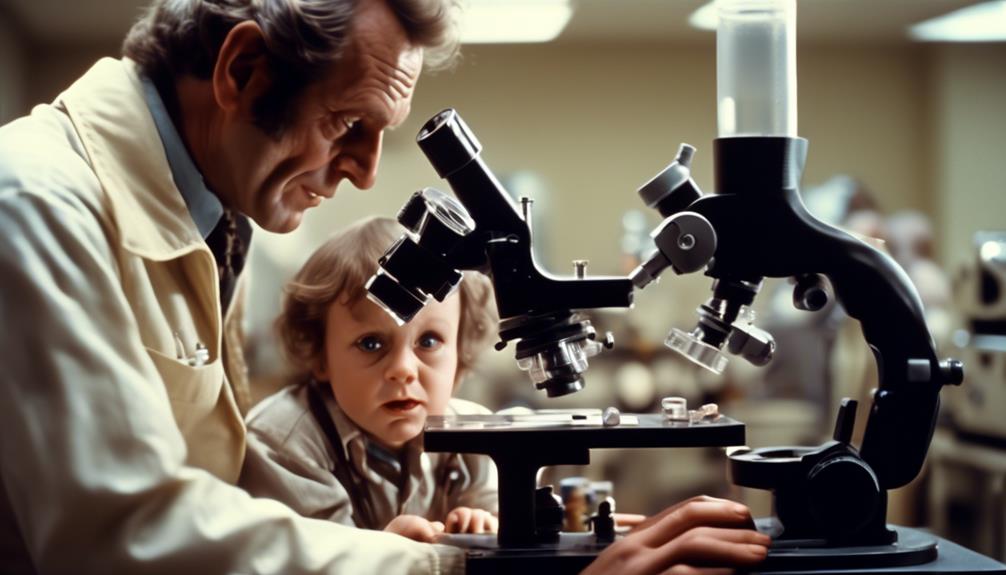Development of in Vitro Fertilization (Ivf) (1978) – Steptoe & Edwards: Recap and Summary: Led to the Birth of the First "Test Tube Baby

The development of in vitro fertilization (IVF) in 1978 by Steptoe and Edwards revolutionized the field of assisted reproduction. This groundbreaking technique led to the birth of the first 'test tube baby', challenging traditional notions of human reproduction.
IVF involves fertilizing an egg with sperm in a laboratory dish before transferring the resulting embryo to the woman's uterus. This technique has provided hope for couples struggling with infertility and has opened up new possibilities for creating families.
Since its introduction, IVF has evolved and improved, with advancements in techniques such as intracytoplasmic sperm injection (ICSI) and preimplantation genetic testing (PGT). These developments have increased success rates and allowed for the selection of embryos with a lower risk of genetic disorders.
IVF has also raised ethical and social questions, including debates about the status of the embryo and the potential for "designer babies." However, it has undeniably had a profound impact on reproductive medicine and has given hope to millions of couples worldwide.
Key Takeaways
- Steptoe and Edwards collaborated in the late 1960s to explore fertilizing human eggs outside the body, leading to the development of the IVF procedure.
- Their collaboration faced challenges including ethical concerns and technical difficulties, but they overcame them through extensive research and experimentation.
- The birth of Louise Brown, the first 'test tube baby', in 1978 was a result of their groundbreaking work and revolutionized reproductive medicine.
- IVF techniques were initially controversial and faced skepticism, but over time, as advancements were made and success rates increased, acceptance and understanding grew.
The Early Years: Steptoe and Edwards' Collaboration
During the early years of the development of In Vitro Fertilization (IVF), the collaboration between Steptoe and Edwards played a pivotal role in advancing the field. Dr. Patrick Steptoe, a gynecologist, and Dr. Robert Edwards, a physiologist, joined forces in the late 1960s to explore the possibility of fertilizing human eggs outside the body. Their collaboration led to the development of the IVF procedure, which revolutionized the treatment of infertility.
Together, Steptoe and Edwards faced numerous challenges, including ethical concerns and technical difficulties. They persevered, conducting extensive research and experimenting with different techniques. In 1978, their hard work paid off when Louise Brown, the world's first 'test tube baby,' was born. This breakthrough not only gave hope to countless couples struggling with infertility, but it also laid the foundation for future advancements in assisted reproductive technology.
The Steptoe-Edwards collaboration was characterized by a dynamic exchange of ideas and expertise. Steptoe's surgical expertise combined with Edwards' knowledge of reproductive biology allowed them to refine the IVF procedure and improve its success rates. Their partnership served as a model for interdisciplinary collaboration in the field of reproductive medicine.
The Steptoe-Edwards collaboration not only paved the way for the birth of IVF but also sparked a global revolution in reproductive healthcare. Today, IVF is a widely accepted and successful treatment option for couples facing infertility, giving them the freedom to pursue their dreams of starting a family.
Overcoming Scientific and Ethical Challenges
Steptoe and Edwards faced significant scientific and ethical challenges as they worked towards the development of In Vitro Fertilization (IVF). The process of IVF required scientific advancements in the understanding of human reproduction and the development of techniques to manipulate human eggs and sperm outside the body. This involved conducting extensive research and experimentation to refine the procedures and ensure their safety and efficacy.
Additionally, Steptoe and Edwards also had to navigate numerous moral dilemmas associated with IVF. The concept of creating life outside the natural process of conception raised questions about the sanctity of life and the potential consequences of manipulating human reproduction. They had to consider the ethical implications of embryo freezing, selective reduction, and the fate of unused embryos.
Despite these challenges, Steptoe and Edwards remained committed to their goal of helping infertile couples conceive. Through perseverance and groundbreaking scientific advancements, they were able to overcome these obstacles and pave the way for the birth of the first 'test tube baby'.
Their work not only revolutionized the field of reproductive medicine but also opened up new possibilities for millions of couples worldwide.
The Breakthrough: Successful IVF Procedure
The successful IVF procedure marked a significant milestone in the field of reproductive medicine. It opened up new possibilities for couples struggling with infertility and paved the way for future advancements in assisted reproductive technology.
Here are four key points to enjoy about the breakthrough:
- Successful outcomes: The first successful IVF procedure resulted in the birth of Louise Brown on July 25, 1978. This historic event brought hope to countless couples worldwide and proved that conception was possible outside the human body.
- Overcoming challenges: The IVF procedure faced numerous scientific and ethical challenges. However, the dedication and perseverance of Dr. Robert Edwards and Dr. Patrick Steptoe led to the development of a viable technique, which involved fertilizing an egg with sperm in a laboratory dish and then transferring the resulting embryo into the woman's uterus.
- Reproductive revolution: The success of IVF revolutionized the field of reproductive medicine. It not only provided a solution for infertility but also opened doors for other assisted reproductive technologies like intracytoplasmic sperm injection (ICSI), preimplantation genetic testing (PGT), and frozen embryo transfer (FET).
- Future advancements: Since the first IVF success, the technique has continued to evolve and improve. Today, IVF has become a widely accepted and successful treatment option, with advancements in laboratory techniques, embryo selection, and cryopreservation techniques. These developments have increased success rates and expanded the possibilities for couples seeking to start a family.
As the field of reproductive medicine continues to progress, the future holds exciting prospects for further advancements in IVF and other assisted reproductive technologies, offering hope to even more couples around the world.
Pregnancy and Controversy Surrounding Louise Brown's Birth
Controversy surrounded the birth of Louise Brown, the first baby conceived through in vitro fertilization (IVF), due to ethical concerns and societal skepticism. The use of IVF to achieve pregnancy was considered controversial at the time, as it involved techniques that weren't widely accepted or understood. Many questioned the ethics of manipulating human reproduction in a laboratory setting, particularly the creation of embryos outside of the womb. Some argued that it went against natural conception and the sanctity of life.
The controversy surrounding Louise Brown's birth also extended to concerns about the long-term effects of IVF on the child and the potential risks involved. Critics worried about the potential for physical and psychological harm to the child, as well as the potential for abuse or misuse of the technology.
Despite these concerns, the birth of Louise Brown marked a significant milestone in reproductive medicine, paving the way for further advancements in IVF and other assisted reproductive technologies. Over time, as the techniques and understanding of IVF improved, the controversy surrounding its use diminished. Today, IVF is a widely accepted and successful method of achieving pregnancy for couples struggling with infertility.
Public Reaction and Media Attention
Media attention and public reaction to the birth of Louise Brown, the first baby conceived through in vitro fertilization (IVF), was overwhelming. Here are four key points to understand the public perception and media coverage surrounding this groundbreaking event:
- Hope and Excitement: The birth of Louise Brown brought immense hope to couples struggling with infertility. IVF was seen as a ray of light, offering a chance at parenthood to those previously without options. The public was excited to witness this medical milestone.
- Ethical Concerns: While many celebrated the success of IVF, others raised ethical concerns. Questions about the sanctity of life and the potential for 'designer babies' were hotly debated. The media played a vital role in shaping public opinion by presenting different perspectives on these issues.
- Curiosity and Intrigue: The media frenzy surrounding Louise Brown's birth was unprecedented. Journalists from around the world flocked to the hospital where she was born. The public was captivated by the idea of a 'test tube baby' and eager to learn more about the science behind IVF.
- Breakthrough in Reproductive Medicine: The media coverage of Louise Brown's birth helped raise awareness about the potential of IVF. It sparked interest in further research and development, leading to advancements in reproductive medicine that have helped countless couples conceive.
Impact on the Field of Assisted Reproduction
The birth of Louise Brown through in vitro fertilization (IVF) not only brought hope and excitement to couples struggling with infertility, but it also had a profound impact on the field of assisted reproduction. IVF quickly became a groundbreaking technique that revolutionized the way infertility was treated.
One significant impact of IVF on the field of assisted reproduction is the ethical considerations it raised. IVF involves the creation and manipulation of embryos outside the body, leading to ethical discussions surrounding the status and rights of these embryos. This has prompted ongoing debates about embryo freezing, donation, and disposal.
Another impact of IVF is the improvement in success rates. Over the years, advancements in IVF techniques and technologies have significantly increased the chances of a successful pregnancy. Today, success rates vary depending on factors such as the age of the woman, the quality of the embryos, and the expertise of the fertility clinic. However, on average, success rates have improved, giving couples struggling with infertility a greater chance of conceiving.
The impact of IVF on the field of assisted reproduction can't be overstated. It hasn't only provided hope to countless couples, but it has also prompted discussions on ethical considerations and led to improvements in success rates. As the field continues to evolve, it's likely that IVF will continue to play a significant role in helping couples achieve their dream of having a child.
Advances and Improvements in IVF Technology
Significant advances and improvements have been made in IVF technology since its development in 1978. Here are four key innovations that have revolutionized the field:
- Blastocyst culture: In the past, embryos were transferred into the womb after two to three days of growth. However, with the introduction of blastocyst culture, embryos can now be cultured for five to six days. This allows embryologists to select the most viable embryos for transfer, increasing the chances of success.
- Preimplantation genetic testing (PGT): PGT is a groundbreaking technique that allows for the screening of embryos for genetic abnormalities before implantation. This enables couples with known genetic disorders to avoid passing them on to their children and increases the success rates of IVF by selecting healthy embryos.
- Intra-cytoplasmic sperm injection (ICSI): ICSI is a technique where a single sperm is injected directly into the egg. This method has greatly improved the success rates of IVF for couples with male infertility issues, as it bypasses the need for natural fertilization.
- Frozen embryo transfer (FET): Freezing embryos for future use has become a routine practice in IVF. FET allows for better synchronization between the embryo and the woman's reproductive cycle, leading to higher success rates and reduced risks of complications.
These advances in IVF technology have transformed the field, making it more accessible, efficient, and successful for couples struggling with infertility.
Legacy of Steptoe and Edwards: A Hopeful Future for Infertility Treatment
Steptoe and Edwards' groundbreaking work in developing IVF has paved the way for a hopeful future in infertility treatment. Their pioneering efforts have revolutionized the field, giving hope to millions of couples struggling with infertility worldwide.
Thanks to their work, IVF has become a widely accepted and successful treatment option for couples facing fertility challenges. It has allowed many individuals to fulfill their dream of becoming parents, offering a glimmer of hope where it once seemed impossible.
The legacy of Steptoe and Edwards extends beyond the birth of the first 'test tube baby.' Their breakthrough has spurred further advancements in infertility treatment, leading to improved success rates and increased accessibility. Today, assisted reproductive technologies such as intracytoplasmic sperm injection (ICSI), preimplantation genetic testing (PGT), and frozen embryo transfer (FET) have further enhanced the chances of conceiving through IVF.
Moreover, ongoing research and innovation continue to push the boundaries of infertility treatment. Scientists are exploring new techniques like mitochondrial replacement therapy and uterine transplantation, offering even more possibilities for couples struggling with infertility.
With each passing year, the hopeful future of infertility treatment becomes brighter. Steptoe and Edwards' pioneering work has laid a solid foundation, and the advancements that followed have only strengthened the potential for success in helping individuals and couples overcome infertility challenges.
Frequently Asked Questions
What Were the Specific Scientific and Ethical Challenges Faced by Steptoe and Edwards During the Development of Ivf?
During the development of IVF, Steptoe and Edwards faced specific scientific challenges such as perfecting the technique of fertilizing eggs outside the body. They also grappled with ethical issues like the status of embryos and the potential for multiple births.
How Did the Successful IVF Procedure Impact the Field of Assisted Reproduction?
Having the first successful IVF procedure revolutionized the fertility industry, offering hope to millions struggling to conceive. However, it also raised ethical implications, prompting ongoing discussions about the limits of assisted reproduction.
What Controversies Surrounded the Birth of Louise Brown, the First 'Test Tube Baby'?
The controversies surrounding the birth of Louise Brown, the first 'test tube baby,' included ethical challenges about playing God and the commodification of human life. These raised important questions about the limits of science and the value of human existence.
How Did the Public React to the News of the Successful IVF Procedure and Louise Brown's Birth?
The public reacted with amazement and curiosity to the news of the successful IVF procedure and Louise Brown's birth. This breakthrough had a significant societal impact, sparking conversations about fertility, ethics, and the possibilities of reproductive technology.
What Advances and Improvements Have Been Made in IVF Technology Since the Breakthrough Procedure in 1978?
Since 1978, advances in IVF technology have led to significant improvements. One interesting statistic is that the success rate of IVF has increased from around 10% to over 40% today, giving hope to many couples struggling with fertility issues.









